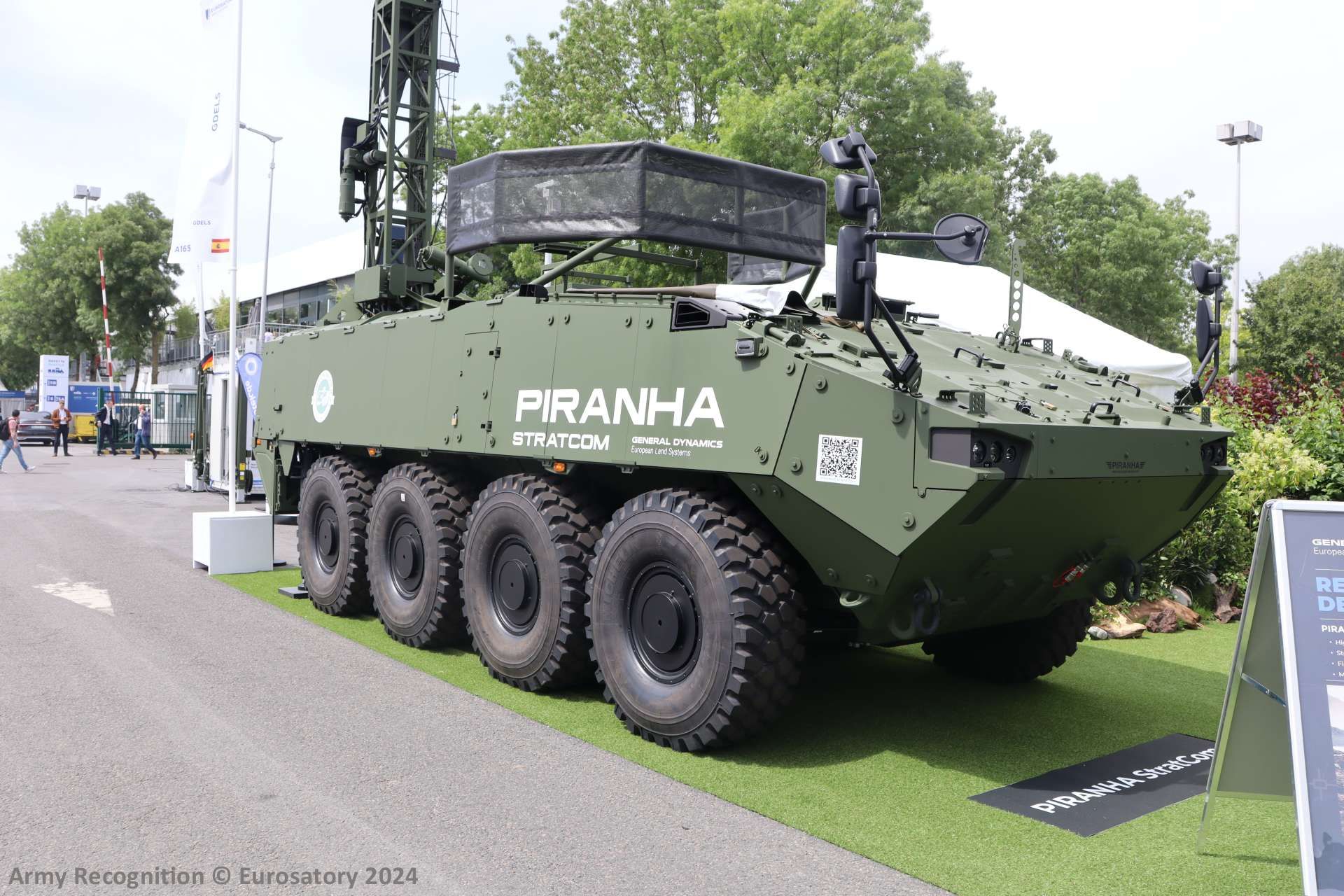Breaking News
GDELS develops a new Piranha Stratcom 8x8 vehicle with a 15-meter mast for the Swiss Army.
At the Eurosatory 2024 exhibition, General Dynamics European Land Systems (GDELS) showcased several new variants of the Piranha V 8x8 vehicle, including the Piranha Stratcom. Developed for the Swiss Army, the Piranha Stratcom is designed for deploying strategic and tactical communication systems and features a deployable mast system capable of supporting a 300 kg payload at a height of 15 meters.
Follow Army Recognition on Google News at this link

At the Eurosatory 2024 exhibition, General Dynamics European Land Systems (GDELS) showcased several new variants of the Piranha V 8x8 vehicle, including the Piranha Stratcom developed for the Swiss Army. (Picture source: Army Recognition)
The Piranha Stratcom shares a powertrain with other members of the Piranha V family, ensuring logistical commonality. It offers ballistic protection and resilience against mines and improvised explosive devices (IEDs), similar to other models in the family. According to the manufacturer, this vehicle is positioned as a modern variant for the C4I (Command, Control, Communications, Computers, and Intelligence) role.
C4I, which stands for Command, Control, Communications, Computers, and Intelligence, is a framework used primarily in the military and defense sectors. It integrates these five capabilities to facilitate operational planning and execution. A C4I system is designed to improve situational awareness, support decision-making processes, and streamline communication among various units. Recent developments for these systems incorporate technologies such as artificial intelligence, unmanned systems, and cyber capabilities to enhance interconnectedness and adaptability in battlefield environments. These systems are crucial for modern military operations, enabling real-time information sharing and coordination across different domains and platforms.
The Piranha Stratcom's high payload capacity and large interior provide working conditions that offer full protection for mission systems and long-range communication operators. The troop compartment can accommodate numerous racks associated with the communications system, with the mast including microwave repeaters for line-of-sight communications. This configuration makes it suitable for linking strategic communications systems with tactical units on the battlefield. The Piranha Stratcom also features a 15-meter mast system, which can be equipped with customer-specific technology, including various antennas for point-to-point radio operations.

The Piranha Stratcom also features a 15-meter mast system, which can be equipped with customer-specific technology up to 300 kg, including various antennas for point-to-point radio operations. (Picture source: GDELS and Army Recognition)
Additional features include a pair of hydraulic legs at the rear to stabilize the vehicle when the mast is deployed, a protective structure for the antenna equipment on or in the roof, and several cooling units for the electronic equipment. The internal layout is adaptable to client requirements, as demonstrated by an augmented reality application showing different configurations of equipment, operator stations, and other key elements such as the powertrain and driving position.
The Piranha series of vehicles, initially developed by the Swiss company MOWAG (now part of General Dynamics European Land Systems), is a versatile family of wheeled armored vehicles. Since its inception in the early 1970s, the Piranha has undergone several iterations, including 4x4, 6x6, 8x8, and 10x10 variants, to meet a range of military requirements. The first model, the Piranha I, was designed as a light reconnaissance and attack vehicle, setting the foundation for future developments. Over the decades, the Piranha vehicles have been adopted by various armed forces worldwide, including the US Army with their Stryker vehicles, which are variants of the Piranha III.

The troop compartment can accommodate numerous racks associated with the communications system, with the mast including microwave repeaters for line-of-sight communications. (Picture source: Army Recognition)
The latest in the series, the Piranha V, is an 8x8 wheeled armored vehicle featuring ballistic protection and can be fitted with modular armor and active protection systems to defend against mines, IEDs, and explosively formed penetrators (EFPs). Deployed in conflict zones like Iraq and Afghanistan, the vehicle accommodates up to 13 personnel and supports various weapon systems, including light weapon stations and heavy turrets like the LANCE 30mm Modular Turret System. It is powered by an MTU 6V199 TE20 diesel engine, providing a top speed of 100 km/h and a range of 550 km.
Countries such as Denmark, Romania, and Spain have adopted the Piranha V. Denmark ordered 309 vehicles in 2015, delivered in variants including engineer, infantry, and ambulance configurations. Romania's contract in 2018 included 227 units, while Spain ordered 348 vehicles in 2020, with plans to expand to 1,000 units. These vehicles are locally produced by TESS Defence, a consortium of Spanish defense companies.
In recent years, the Piranha V family has continued to evolve. For instance, the newly introduced Piranha Advanced Artillery Carrier (AAC) 10x10 variant features an unmanned 155mm artillery gun module (AGM), while the Piranha Sappeur represents the latest 8x8 armored engineering vehicle developed for the Swiss Army. This evolution and adaptation to new military requirements have resulted in the Piranha's widespread use, with over 12,000 units in service across more than 20 countries.

The Piranha V is powered by an MTU 6V199 TE20 diesel engine, providing a top speed of 100 km/h and a range of 550 km. (Picture source: Army Recognition)


























